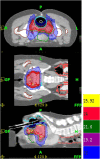Should helical tomotherapy replace brachytherapy for cervical cancer? Case report
- PMID: 21092235
- PMCID: PMC3001446
- DOI: 10.1186/1471-2407-10-637
Should helical tomotherapy replace brachytherapy for cervical cancer? Case report
Abstract
Background: Stereotactic body radiation therapy (SBRT) administered via a helical tomotherapy (HT) system is an effective modality for treating lung cancer and metastatic liver tumors. Whether SBRT delivered via HT is a feasible alternative to brachytherapy in treatment of locally advanced cervical cancer in patients with unusual anatomic configurations of the uterus has never been studied.
Case presentation: A 46-year-old woman presented with an 8-month history of abnormal vaginal bleeding. Biopsy revealed squamous cell carcinoma of the cervix. Magnetic resonance imaging (MRI) showed a cervical tumor with direct invasion of the right parametrium, bilateral hydronephrosis, and multiple uterine myomas. International Federation of Gynecology and Obstetrics (FIGO) stage IIIB cervical cancer was diagnosed. Concurrent chemoradiation therapy (CCRT) followed by SBRT delivered via HT was administered instead of brachytherapy because of the presence of multiple uterine myomas with bleeding tendency. Total abdominal hysterectomy was performed after 6 weeks of treatment because of the presence of multiple uterine myomas. Neither pelvic MRI nor results of histopathologic examination at X-month follow-up showed evidence of tumor recurrence. Only grade 1 nausea and vomiting during treatment were noted. Lower gastrointestinal bleeding was noted at 14-month follow-up. No fistula formation and no evidence of haematological, gastrointestinal or genitourinary toxicities were noted on the most recent follow-up.
Conclusions: CCRT followed by SBRT appears to be an effective and safe modality for treatment of cervical cancer. Larger-scale studies are warranted.
Figures






Similar articles
-
National Cancer Data Base analysis of radiation therapy consolidation modality for cervical cancer: the impact of new technological advancements.Int J Radiat Oncol Biol Phys. 2014 Dec 1;90(5):1083-90. doi: 10.1016/j.ijrobp.2014.07.017. Epub 2014 Sep 9. Int J Radiat Oncol Biol Phys. 2014. PMID: 25216857
-
Analysis of the effect of adjuvant radiotherapy on outcomes and complications after radical hysterectomy in FIGO stage IB1 cervical cancer patients with intermediate risk factors (GOTIC Study).World J Surg Oncol. 2016 Jun 29;14(1):173. doi: 10.1186/s12957-016-0931-4. World J Surg Oncol. 2016. PMID: 27356862 Free PMC article.
-
Chemoradiation in cervical cancer with cisplatin and high-dose rate brachytherapy combined with external beam radiotherapy. Results of a phase-II study.Strahlenther Onkol. 2002 Jul;178(7):378-85. doi: 10.1007/s00066-002-0956-1. Strahlenther Onkol. 2002. PMID: 12163992 Clinical Trial.
-
Treatment results of high-dose-rate remote afterloading brachytherapy for cervical cancer and retrospective comparison of two regimens.Int J Radiat Oncol Biol Phys. 2003 Apr 1;55(5):1254-64. doi: 10.1016/s0360-3016(02)04525-x. Int J Radiat Oncol Biol Phys. 2003. PMID: 12654435 Review.
-
Cervical cancer: combined modality therapy.Cancer J. 2001 Jul-Aug;7 Suppl 1:S47-50. Cancer J. 2001. PMID: 11504285 Review.
Cited by
-
Brachytherapy-emulating robotic radiosurgery in patients with cervical carcinoma.Radiat Oncol. 2013 May 2;8:109. doi: 10.1186/1748-717X-8-109. Radiat Oncol. 2013. PMID: 23638755 Free PMC article.
-
VMAT for the treatment of gynecologic malignancies for patients unable to receive HDR brachytherapy.J Appl Clin Med Phys. 2014 Sep 8;15(5):4839. doi: 10.1120/jacmp.v15i5.4839. J Appl Clin Med Phys. 2014. PMID: 25207568 Free PMC article.
-
What is the evidence for the clinical value of SBRT in cancer of the cervix?Rep Pract Oncol Radiother. 2018 Nov-Dec;23(6):574-579. doi: 10.1016/j.rpor.2018.08.005. Epub 2018 Oct 9. Rep Pract Oncol Radiother. 2018. PMID: 30534021 Free PMC article. Review.
-
Robotic radiosurgery as an alternative to brachytherapy for cervical cancer patients.Strahlenther Onkol. 2014 Jun;190(6):538-45. doi: 10.1007/s00066-014-0614-4. Epub 2014 Mar 4. Strahlenther Onkol. 2014. PMID: 24589918
-
Is there a role for an external beam boost in cervical cancer radiotherapy?Front Oncol. 2013 Jan 30;3:3. doi: 10.3389/fonc.2013.00003. eCollection 2013. Front Oncol. 2013. PMID: 23386995 Free PMC article.

